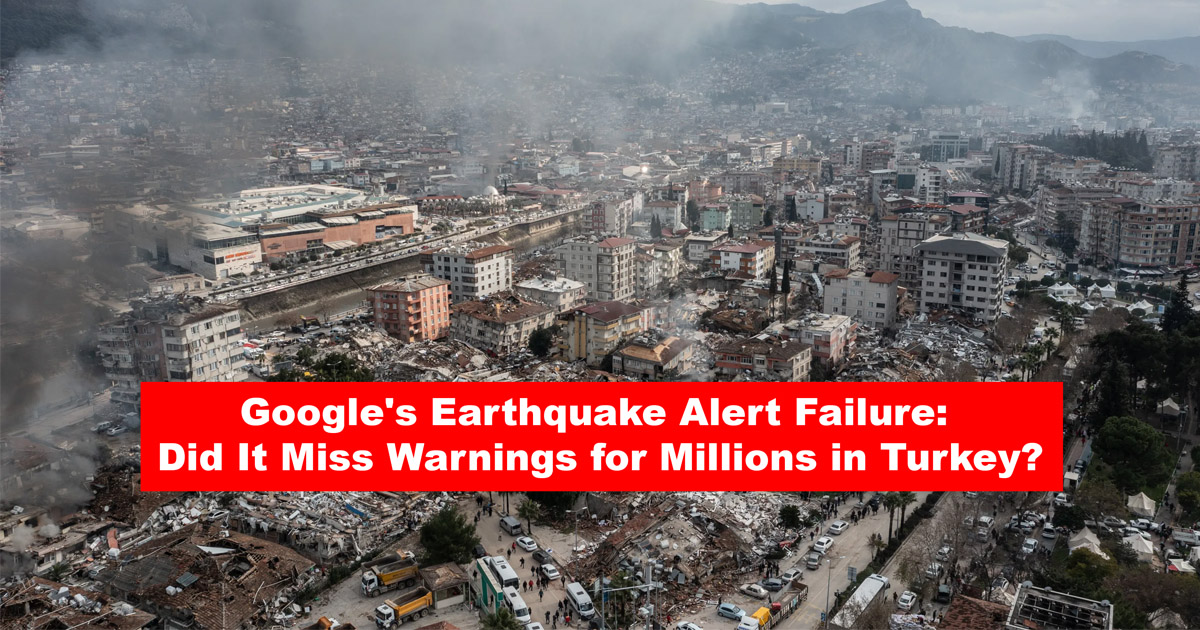Google has come out to say that its Android Earthquake Alerts (AEA) software failed to give critical warnings to people in Turkey prior to the deadly earthquake there on February 6, 2023. More than 55,000 people were killed and over 100,000 injured in the resultant magnitude-7.8 quake.
During the AEA system activity, it significantly miscalculated the strength of the earthquake with weak warnings. The highest level, the so-called Take Action alert designed to take immediate precautions was logged by 469 individuals, although some 9-10 million citizens resided within a range of 98 miles of the epicentre.
Rather, approximately 500,000 users were notified by a lesser degree “Be Aware”, made to target minor, less noticeable quakes. The settings like Do Not Disturb can be used to cancel this alert and most individuals including individuals who might have been asleep when the first shaking started in AM 4:17 are likely to have missed the alert.
To begin with, Google asserted that the system had recorded well. However, according to internal findings, the app had confused the magnitude of the quake, estimating it between 4.5 to 4.9 whereas it was rated as 7.8. Another tremor the same day also had the same mistakes: 8,158 Take Action warnings were given and nearly four million Be Aware ones: that, too, was not enough.
As Google told the BBC, it is refining the system depending on what it learns in each quake. The AEA system is adapted to the sensor in Android phone to observe the movement of the ground, which gives the user a few seconds of the time to respond before the earthquake waves reach them. Once a heavy shake is sensed, the system must play the loud Take Action message which bypasses all other settings and fills the screen of the user.
In Turkey, this warning would have assisted people to evacuate prior to collapse of buildings. Months after BBC was covering the quake zone on BBC on TV, no user came out saying they had seen the more serious alert prior to the first shake.
Following the earthquake Google released a study in the journal Science where it acknowledged that its detection algorithms had limitations. Scientists performed a re-designed simulation of the 7.8 quake and statistical results were dramatically different, 10 million messages on Take Action and 67 million messages on Be Aware, and this may indicate that the original version of software was faulty.
The challenges on such systems are the capability to fine-tune their algorithms with larger events but Google has recognized the challenge all earthquake warning systems have, however, there is criticism over the delay in the revelation by the analysts. Assistant professor Elizabeth Reddy at Colorado School of Mines wrote in a blog, “I am really frustrated that it took so long.” It is not a small incident that people died but we did not witness this caution on stage as we would have liked it to be.
There is also concern among the scientists that nations may over-depend on the alerts given by Google and omit on developing national warning systems. According to Harold Tobin, the director of the Pacific Northwest Seismic Network, some locations might think, why bother making this determination as Google will do it. I believe transparency level in saying how well it works is of utmost importance.”
Google is insisting its platform is only complementary to national alert systems. The company has revised the algorithm and upscaled the Android Earthquake Alerts system to 98 countries since the 2023 earthquake.
Swapnil is a passionate writer who specializes in creating engaging and informative articles. With a knack for storytelling, he covers a wide range of topics, providing readers with valuable insights and fresh perspectives. Whether it's about trends, lifestyle, or creativity, Swapnil's writing aims to educate, inspire, and entertain.


